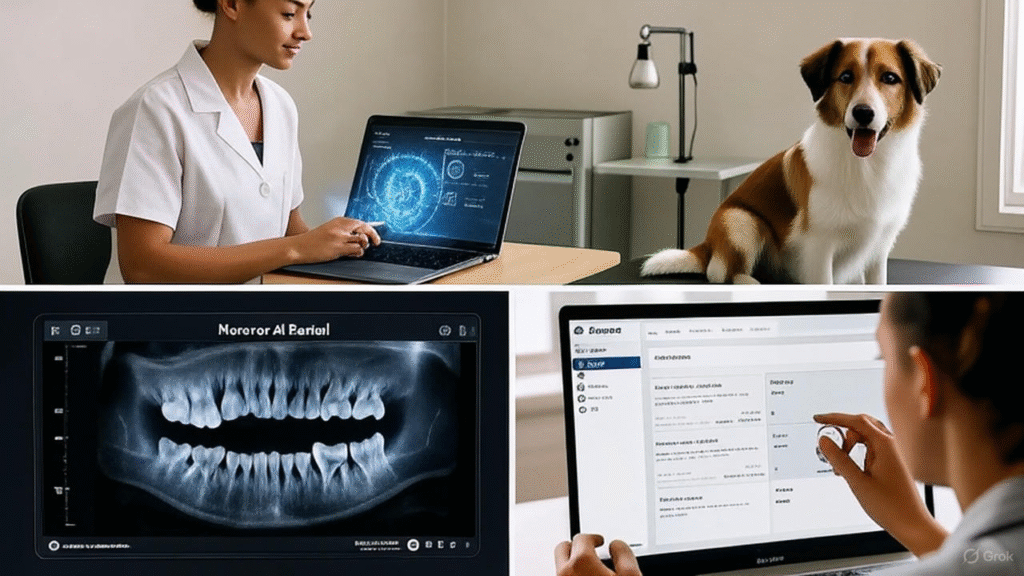
Imagine taking your furry friend to the vet for a dental check-up, and within minutes, advanced AI pinpoints issues like hidden cavities or gum disease that might otherwise go unnoticed. That’s the promise of Nerovet AI Dental, a groundbreaking platform that’s transforming veterinary dentistry. Launched in mid-2025, this AI-powered tool helps veterinarians deliver faster, more accurate care to pets, improving outcomes and easing the stress for both animals and their owners. In this article, we’ll dive into what Nerovet is, how it works, its key features, benefits, real-world examples, and more—equipping you with everything you need to know about this innovative technology.
Whether you’re a pet owner curious about better dental care for your dog or cat, or a veterinarian looking to enhance your practice, Nerovet bridges cutting-edge tech with everyday animal health. Let’s explore how it’s making waves in the vet world.
What Is Nerovet AI Dental?
Nerovet AI Dental is an advanced AI platform designed specifically for veterinary oral health. It combines artificial intelligence, machine learning, and dental imaging to assist vets in diagnosing and treating dental problems in animals like dogs, cats, and even larger pets. Unlike traditional methods that rely solely on visual exams and X-rays interpreted by humans, Nerovet uses sophisticated algorithms to analyze images and data for precise insights.
This tool emerged as part of the growing trend in AI for veterinary care, where technology helps detect issues early and personalize treatments. According to industry reports, up to 80% of dogs over three years old suffer from dental disease, making tools like Nerovet essential for preventive care. It’s not just about spotting problems—it’s about making vet visits more efficient and effective.
How Does Nerovet AI Dental Work?
At its core, Nerovet integrates with existing veterinary imaging equipment, such as X-rays or intraoral cameras. Here’s a step-by-step breakdown:
- Image Capture: The vet takes dental images of the pet’s mouth.
- AI Analysis: The platform’s machine learning algorithms scan the images in real-time, identifying issues like periodontal disease, tooth fractures, or cavities.
- Data Integration: It combines this with patient history, breed-specific risks, and predictive analytics to suggest treatments.
- Reporting: Generates easy-to-understand reports with visuals for vets to share with pet owners.
- Learning Loop: The system improves over time by learning from new data, refining accuracy across different animal breeds and sizes.
This process can reduce diagnostic time significantly, with some clinics reporting up to a 40% faster identification of issues compared to manual methods.
Key Features of Nerovet AI Dental
Nerovet stands out with its user-friendly design and powerful capabilities. Key features include:
- Advanced Imaging Analysis: Detects subtle problems in X-rays that might be missed by the human eye, with high accuracy for conditions like gum disease.
- Real-Time Diagnostics: Provides instant feedback during exams, allowing for on-the-spot treatment decisions.
- Predictive Analytics: Forecasts potential future issues based on breed, age, and history, enabling preventive care.
- Seamless Integration: Works with most veterinary practice management software, automating records and scheduling.
- Comprehensive Reports: Includes visuals and explanations to help communicate with pet owners effectively.
These features make it accessible even for vets with limited tech experience, requiring minimal training.
Benefits for Veterinarians and Pet Owners
For veterinarians, Nerovet boosts efficiency by streamlining workflows and reducing errors. Clinics using similar AI tools have seen a 20% drop in treatment times and higher success rates in procedures like extractions or cleanings. It frees up time for more patient interactions, increasing overall productivity.
For pet owners, the benefits are clear: earlier detection means less pain for pets and fewer costly emergencies. Transparent reports build trust, helping owners understand their pet’s oral health. Plus, personalized plans can extend a pet’s healthy lifespan, with studies showing AI-aided care improving outcomes by up to 15% in complex cases.
Overall, it’s cost-effective, minimizing unnecessary procedures and fostering stronger vet-client relationships.
Real-World Applications and Case Studies
Nerovet is already making an impact. In a California veterinary clinic, integration led to quicker diagnostics, cutting exam times and improving pet comfort. A New York practice used it for periodontal cases, where AI suggestions resulted in tailored plans and better recovery rates.
In Texas, an animal hospital applied Nerovet’s analytics for preventive tracking, catching issues early in breeds prone to dental problems like small dogs. A Canadian mixed-practice saw increased productivity and client satisfaction through easier documentation.
These examples highlight how Nerovet turns data into actionable insights for real pets.

Challenges and Considerations
While promising, Nerovet isn’t without hurdles. Initial setup costs and training can be a barrier, though long-term savings offset this. Data privacy is key, with the platform complying with standards like GDPR to protect pet records. Some vets may face a learning curve, and pet owners need education to trust AI.
To adopt successfully, start with staff training and gradual integration. For more on AI in vet care, check resources from the American Veterinary Medical Association (avma.org).
Conclusion
Nerovet AI Dental is paving the way for smarter, safer veterinary oral health, blending AI with compassionate care to benefit pets everywhere. By enhancing diagnostics, personalizing treatments, and streamlining practices, it’s a game-changer for the industry. If you’re a pet owner, ask your vet about AI tools like Nerovet. Veterinarians, consider exploring this technology to elevate your services—your patients (and their owners) will thank you.


